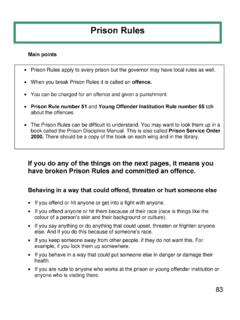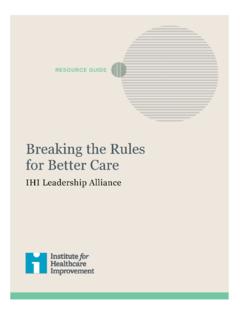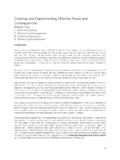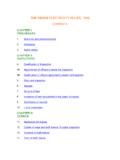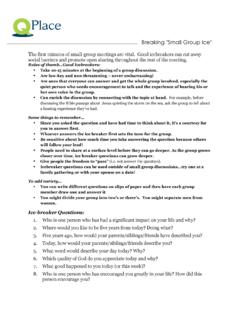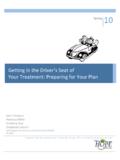Transcription of BREAKING THE CYCLE OF STUDENT MISBEHAVIOR
1 13. BREAKING THE. CYCLE OF STUDENT . MISBEHAVIOR . When the going gets tough, the tough get supportive.. 200. F. and situations, employing O R PA RT I C U L A R LY T O U G H K I D S. all the approaches outlined in previous chapters doesn't do the trick. Even with the use of heavy-duty consequences, some kids continue to break the rules. What then? How do we help our students make permanent positive changes? While there are no guaranteed solutions, the most effective approaches arise out of our tried-and-true combination of assuming the best and BREAKING things into parts, as shown in all the strategies described below. Assumptions that Make a Difference Addressing the causes To get to the root of STUDENT misbehaviors, we may need to address the reasons behind them.
2 This doesn't always seem practical, given the limited time we have. But it can make all the difference. 201. 202 CONSCIOUS CLASSROOM MANAGEMENT. Id Bright eas Why students act out When they don't understand the lesson, they may choose to push away feeling inadequate. They'd much rather see themselves as behavior problems than slow learners. They feel frustrated because they don't get it, and rather than treat frustration as a doorway into learning, they push it away, and end up acting out. It's possible that the lesson is inappropriate for them, and they act out as a communication to the teacher to change the lesson or the approach. It's possible that the behavior the teacher expects is unrealistic.
3 The teacher has been reacting at them rather than responding with them. They are having problems at home. They are using drugs. Although drug use is often viewed as a symptom of underlying problems, once done with regularity, drugs can become the problem. They are having trouble with medication not taking it, taking it too much, or not taking it regularly. They have emotional tension with peers. They are being bullied and/or intimidated by classmates. They are struggling in other classes. A myriad of other reasons, both in and out of the classroom. students don't act out because they are bad people. They are simply looking for ways to establish and maintain a sense of self while navigating through the sometimes extreme experiences they have.
4 When a STUDENT acts out, it is often a call for help. By addressing these calls directly and honing in on solutions, we provide students with a chance to make real and lasting changes. If in our investigation B R E A K I N G T H E C Y C L E O F S T U D E N T M I S B E H AV I O R 203. we discover reasons beyond our control, we can at least gain com- passion for our students and ourselves, knowing what can and can't be changed. Helpful approaches Positive connections A Closer Look Talking with Mark about his life requires that the When a teacher establish strong positive connections with him. STUDENT acts Many strategies for this are outlined in Chapter 7, Positive out, it is often a Connections. The essence of all the strategies is simply to call for help.
5 By addressing these talk with him not about his poor behavior, but about calls directly and anything he's interested in. Give him a chance to have per- honing in on sonal time with us when we are not playing the role of solutions, we authoritarian. Make this an ongoing commitment. It provide students won't be easy, especially at first. He'll likely be wary of with a chance to make real and our sudden interest in his life. But if we stick with it, casu- lasting changes. ally and consistently over the course of days not as a one-time frontal assault we'll notice that gradually Mark becomes more forthcoming, more involved, and more com- mitted to succeeding in the class. I-Statements and active listening students like Mark want to feel respected and Mrs.
6 Allgood says heard. One way is for the teacher to make an effort to listen closely and fully to what he has to say. It Give students helps to repeat back to him what we hear, to make a chance to have personal sure the communication is clear. For example, I hear time with us when we you saying that you think it's unfair that I singled you are not playing the out when others were talking as well. role of authoritarian. It also helps to make statements about ourselves, using the word I. An example would be, I feel concerned when I give the class a direction and you come up right afterwards to ask me what it was. I-statements help disarm situ- ations. Because we are not directly making claims about Mark, he won't be as inclined to want to defend himself.
7 204 CONSCIOUS CLASSROOM MANAGEMENT. Listening is powerful. It's often enough to help the STUDENT turn around. If not, it can help us figure out the cause of the prob- lem, giving us a chance to find simple solutions. If students are hungry, sometimes the best thing we can do is to feed them If students keep calling out for attention, let's find ways to give it to them that assist the class, rather than disrupt it. We can give classroom jobs to our students ; they can be in charge of supplies, pets and plants, collecting and/or passing out papers, designing bulletin boards, taking messages to other teachers, record keep- ing, welcoming new students , orientating other students to the computer. We can involve them in teaching their peers or teach- ing younger students from other classes.
8 If students are fidgety and feel the need to move, Mrs. Allgood says let's provide them with the opportunity. Consultant If students Alan Mendler suggests that teachers use bungee keep calling cords or surgical elastic for ADHD kids. Tie lengths out for attention, let's find around the four legs of the students ' chair, so that ways to give it to they can push against them with their legs. Above the them that assist the chair, the teacher will see model students , still and class, rather than focused on the lesson. Below the chair will be STUDENT disrupt it. legs moving at a hundred miles an hour. We can build movement into our lessons, by periodically providing students with squeeze-toys or art supplies, or sending them on errands.
9 As we assume that students want to learn, let's also assume that sometimes they just need to move. Five Keys for Permanent Change Sometimes knowing why doesn't help. Other times we can't figure out why. What then? Permanently changing behavior is not easy, for kids or adults just think of all the time, money, and energy adults spend on losing weight and quitting smoking. Nonetheless, in the classroom there are some approaches that do B R E A K I N G T H E C Y C L E O F S T U D E N T M I S B E H AV I O R 205. seem to make a difference in STUDENT behavior. All per- manent change involves one or more of the five keys A Closer Look described below (the first three echo consultant Rick These keys Curwin).
10 students have to: arise when we assume the best 1. Want to change about our students 2. Know how to change that they want 3. Have opportunities to practice changing to behave appropriately, but 4. Be conscious of their choices as they are are stuck on choosing them the details. 5. Receive ongoing support from the teacher These keys arise when we assume the best about our students . that they want to behave appropriately, but are stuck on the details. Below are three examples that help illustrate how these keys can be used to help our students . Example 1. Elementary school Mrs. Allgood teaches a second grade class and her STUDENT Johnny has a terrible time with transitions. During the long-term art project, he is always the last one to put his materials away and return his chair to where it belongs.
